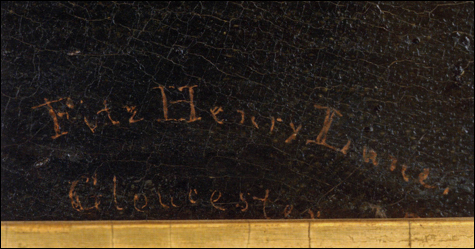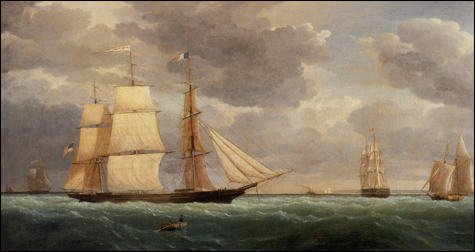Why it’s Fitz Henry, not Fitz Hugh, Lane — and why it matters
By GREG COOK | August 31, 2007

|
| “Fitz Henry Lane & Mary Blood Mellen: Old Mysteries and New Discoveries” | Cape Ann Historical Museum, 27 Pleasant St, Gloucester | Through September 16 |
In 2004, Jane Walsh of Gloucester’s official archives committee did a quick Web genealogy search on 19th-century Gloucester marine painter Fitz Hugh Lane. Her inquiry was prompted by a lecture in which eminent art historian John Wilmerding had discussed one of the persistent Lane mysteries: why, when he was a young boy, did the artist change his name from Nathaniel Rogers Lane.Up popped Lane’s request to change his name to Fitz Henry Lane. Walsh and her committee comrades figured “Henry” must be a mistake, a typo maybe. Still, it was an error they came across with some frequency in Lane records. And so they visited the state archives in Boston to look at Lane’s actual petition.
“And sure enough, there it was: Nathaniel Rogers Lane writing in to ask if he could have his name changed to Fitz Henry Lane,” says co-chair Sarah Dunlap. They realized that Lane had always been Fitz Henry. Fitz Hugh was the error.
The report of the discovery by Dunlap and Cape Ann Historical Museum librarian/archivist Stephanie Buck in the February 2005 issue of the Essex Genealogist heralded a new body of Lane research. Last year, Gloucester historian James Craig published Fitz H. Lane: An Artist’s Voyage Through Nineteenth-Century America (History Press), a biography that provides new insight into Lane’s involvement with the Transcendentalist, Spiritualist, and Temperance movements. Craig even turns up a brief mention that could be proof that Lane taught New Bedford marine painter William Bradford. Also last year, the staff at the Museum of Fine Arts in Boston made the case that Lane used a lens known as a camera lucida to help him trace the contours of landscapes onto his sketches and paintings. This fall, Dunlap and Buck are planning to publish a book on Lane’s years in Gloucester. Wilmerding, meanwhile, has assembled 50 artworks for the Cape Ann Historical Museum’s current exhibit “Fitz Henry Lane & Mary Blood Mellen: Old Mysteries and New Discoveries,” which looks at Lane’s artistic relationship with one of his chief students.

through clouds and falls on sails and waves. |
And yet, the discovery that we’ve had Lane’s name wrong since at least 1913 has prompted questions about what else scholars have gotten wrong about him. Notably what Wilmerding has gotten wrong. He is part of a handful of scholars (others include Barbara Novak and Theodore Stebbins Jr.) who’ve been credited with pioneering scholarship of 19th-century American art. Wilmerding’s “find” was Lane, one of several artists who had fallen into obscurity with the rise of French Impressionism and Modern art. Lane’s work now commands top prices — Skinner Auctioneers in Boston got $5.5 million for Manchester Harbor back in November 2004.Wilmerding, a descendant of major art collectors, began the research that would lead to his first book on Lane, which he published in 1964, while studying at Harvard. He was fortunate to be among the first scholars to examine the collection that Maxim Karolik, a pioneering collector of 18th- and 19th-century American art, had begun donating to the Museum of Fine Arts in 1938. And at the nearby Cape Ann Historical Museum, he had access to the largest collection of Lane works anywhere.
 Related
Related:
Kitchen-sink ‘Summer’, We heart these people, Blinded by the light, More 
- Kitchen-sink ‘Summer’
You wouldn’t think a painting exhibit of ships and still lifes, landscapes and portraits, primitives and abstractions representing 82 artists and spanning 148 years would hold together in any discernible way.
- We heart these people
We all know Portland is a busy, exciting place to live. It takes a lot of people's amazing energy to keep it going, though. Who's doing the moving and the shaking?
- Blinded by the light
The pleasures of scenic seacoasts, lakes at dusk, farms in full fruit, and clam shacks by day or night have attracted artists to New England since at least the mid 19th century.
- Facets of brilliance
The current show in the Isabella Stewart Gardner Museum’s special-exhibition room, “Bellini and the East,” is another flickering jewel in the Gardner’s crown.
- Review: The Edge of Love
John Maybury evoked the genius of Francis Bacon in Love Is the Devil , but he goes off the deep end with this ludicrous soap opera about Dylan Thomas.
- Connected
In 2004, AS220's StinkTank put out a paper titled "Compost and the Arts."
- Painting the end of the world - side
- Majestic rot
Providence artist Neal Walsh’s great new abstract paintings bring to mind peeling paint, rust, and cracking plaster in old mills or houses, maybe the wall in the hall of an apartment building.
- Ralph Hamilton
My lovable, impossible friend of more than 30 years, the artist Ralph Hamilton, died on February 19, of complications from diabetes. He was only 59. It’s a very sad loss. He was one of Boston’s most original and searching painters and had been doing some of his most ambitious and moving work.
- Queering the Code
With close to 60 million copies in print worldwide and a film version starring Tom Hanks opening on May 18, The Da Vinci Code is a galloping success.
- My Baby Shot Me Down
“Abstract painting” is a broad historical category that takes in everything from the utopian spiritual and formal purity of the early decades of the 20th century to the macho of the purely visual as championed by Clement Greenberg later in that century.
- Less

 Topics
Topics:
Museum And Gallery
, William Bradford, Harvard University, Painting, More  , William Bradford, Harvard University, Painting, Visual Arts, Boston Museum of Fine Arts, Cultural Institutions and Parks, Museums, Museum of Fine Arts, Nathaniel Hawthorne, Dartmouth College, Less
, William Bradford, Harvard University, Painting, Visual Arts, Boston Museum of Fine Arts, Cultural Institutions and Parks, Museums, Museum of Fine Arts, Nathaniel Hawthorne, Dartmouth College, Less 